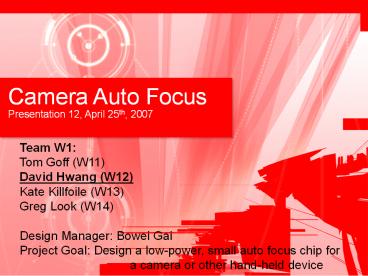Camera Auto Focus - PowerPoint PPT Presentation
Title:
Camera Auto Focus
Description:
Explanation of general camera operation and how focusing works ... Overview of fuzzy-logic algorithm for determining lens-armature movement ' ... – PowerPoint PPT presentation
Number of Views:541
Avg rating:3.0/5.0
Title: Camera Auto Focus
1
Camera Auto Focus
- Presentation 12, April 25th, 2007
Team W1 Tom Goff (W11) David Hwang (W12) Kate
Killfoile (W13) Greg Look (W14) Design Manager
Bowei Gai Project Goal Design a low-power, small
auto focus chip for a camera or other
hand-held device
2
Introduction
- Explanation of general camera operation and how
focusing works - Brief history / overview of existing camera
autofocus methods - Snazzy animation
Dave
3
Usage / Target Market
- Digital Cameras, Security Cameras, Home Video
Cameras
Dave
4
Fuzzy-Logic Autofocus
- Overview of fuzzy-logic algorithm for determining
lens-armature movement - sharpness index differential (di) and average
gain (ag) computed seperately - Resulting values fed into fuzzy-logic chip to
determine final outcomes (graph of di ag zones)
Dave
5
Translation to Hardware
- Computation requires floating-point
justification of 145 field split - Fuzzy Logic means a series of summed products
need a floating point multiplier and floating
point adder - Explain optimization of trading speed for size by
reusing one multiplier and adder
Dave
6
Other Design Goals
- Explain other goals which impacted architecture
space, low power, speed, etc. - Compare to existing solutions
Dave
7
Overall Architecture
- Picture of global signal flow, schematic and
layout - Neat animation of signal flow
- History of past floorplan designs
Greg
8
Integer Adder Architecture
- Explain choice of (integer) adder based on
previously stated design decisions - Comparison to other considered designs
Greg
9
Integer Multiplier Architecture
- Architecture decisions go here
- Alternatives considered, pros/cons
Greg
10
FP Adder Architecture
- Floating Point decisions drove fp adder
architecture decisions - Need precision of denormalized numbers, adds lots
of complexity - Dont need rounding, avoids a lot of complexity
- Fields are small enough that we can determine
leading zeroes combinationally, saves a lot of
time
Greg
11
FP Multiplier Architecture
- Lots of module re-use from the fp adder
- Moved from two two-input multipliers to one
three-input multiplier can save on the pre- and
post-multiplication logic as we only need to
combine exponents / normalize once
Greg
12
Verification
- Layout of full algorithm based on inputs
- C programs to execute algorithm, as well as
sub-programs to deal with conversions from 32-bit
floating point to our 10-bit format - More C to simulate our floating point modules
K8
13
Verification
- Wrote structural Verilog and measured against C
programs able to perform exhaustive testing to
prove matching - Took structural Verilog and created schematics in
Virtuoso tested general and edge cases to prove
correspondence
K8
14
Verification
- Verified module layouts against schematics at
every level - Ran analog simulations on the layouts to test
general and edge cases against expected outputs
from the schematic
K8
15
Layout Stuff
- Neat pictures of our layout layers,
poly/metal1/2/3/4 and transistor/layer density
Tom
16
Simulation Results
- Show results at each stage and how they match up
to the algorithm - Go through one full pass and show numbers and
accumulation - Show delay of critical path and discuss FSM timing
Tom
17
Final Specifications
- Present final chip specs, measure against initial
goals - Area/Density
- Speed
- Power Consumption
- Relate to existing solution
Tom
18
Questions?
All































